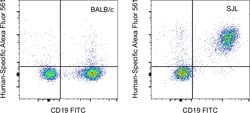Learn More
TNF alpha Monoclonal Antibody (MP6-XT22), Alexa Fluor™ 561, eBioscience™, Invitrogen™
Rat Monoclonal Antibody
$189.55
Specifications
| Antigen | TNF alpha |
|---|---|
| Clone | MP6-XT22 |
| Concentration | 0.2 mg/mL |
| Applications | Flow Cytometry |
| Classification | Monoclonal |
| Catalog Number | Mfr. No. | Quantity | Price | Quantity & Availability | |||||
|---|---|---|---|---|---|---|---|---|---|
| Catalog Number | Mfr. No. | Quantity | Price | Quantity & Availability | |||||
50-573-2180

|
Invitrogen
505732180 |
25 μg |
Each of 1
for $189.55
Save 15% Reg : |
|
|||||
Description
The MP6-XT22 antibody reacts with mouse tumor necrosis factor-alpha (TNF alpha), a 17 kDa cytokine produced by monocytes, macrophages, neutrophils, NK cells and CD4(+) T cells. TNF alpha has cytolytic activity against a range of tumor cells and is important in immune regulation. TNF alpha forms dimers and trimers and also exists as a 26 kDa membrane-bound form.
TNF alpha is a multifunctional proinflammatory cytokine that belongs to the tumor necrosis factor (TNF) superfamily. This cytokine is mainly secreted by macrophage and bind to its receptors, TNFRSF1A/TNFR1 and TNFRSF1B/TNFBR. TNF alpha is involved in the regulation of immune cells, cell proliferation, differentiation, apoptosis, lipid metabolism, and coagulation. TNF alpha exists as a multimer of two, three, or five noncovalently linked units, but shows a single 17 kDa band following SDS-PAGE under non-reducing conditions. Knockout studies in mice also suggested the neuroprotective function of TNF alpha, and has been observed to causes tumor necrosis when injected into tumor-bearing mice. Other functions of TNF-alpha include its role in the immune response to bacterial, viral, parasitic and certain fungal infections, as well as its role in the necrosis of specific tumors. TNF alpha causes cytolysis or cytostasis of certain transformed cells, being synergistic with interferon-gamma in its cytotoxicity. This cytokine has been implicated in a variety of diseases, including autoimmune diseases, insulin resistance, and cancer.Specifications
| TNF alpha | |
| 0.2 mg/mL | |
| Monoclonal | |
| Liquid | |
| RUO | |
| PBS with 0.09% sodium azide; pH 7.2 | |
| APC1 protein; Cachectin; C-domain 1; C-domain 2; cTNF; DADB-70P7.1; DIF; ICD1; ICD2; Intracellular domain 1; Intracellular domain 2; N-terminal fragment; NTF; RATTNF; Tnf; TNF alpha; TNF superfamily; TNF a; TNF, macrophage-derived; TNF, monocyte-derived; TNFA; TNF-a; TNFalpha; TNF-alpha; Tnfsf1a; TNFSF2; TNFa; TNLG1F; Tumor necrosis factor; tumor necrosis factor (TNF superfamily, member 2); tumor necrosis factor alpha; tumor necrosis factor alpha (cachetin); tumor necrosis factor alpha precursor; tumor necrosis factor ligand 1F; tumor necrosis factor ligand superfamily member 2; Tumor necrosis factor, membrane form; Tumor necrosis factor, soluble form; tumor necrosis factor-alpha; tumor necrosis factor-alpha precursor; tumor-necrosis factor; tumour necrosis factor | |
| Tnf | |
| Primary | |
| 4° C, store in dark, DO NOT FREEZE! | |
| Tnf |
| MP6-XT22 | |
| Flow Cytometry | |
| Alexa Fluor 561 | |
| Rat | |
| Mouse | |
| P06804 | |
| 21926 | |
| IgG1 κ | |
| Affinity chromatography | |
| Antibody |
The Fisher Scientific Encompass Program offers items which are not part of our distribution portfolio. These products typically do not have pictures or detailed descriptions. However, we are committed to improving your shopping experience. Please use the form below to provide feedback related to the content on this product.

